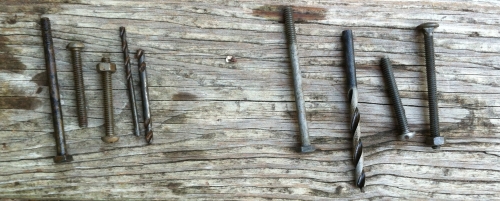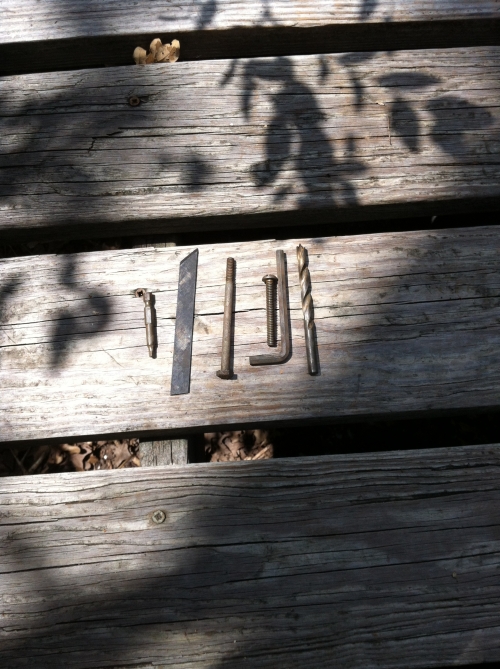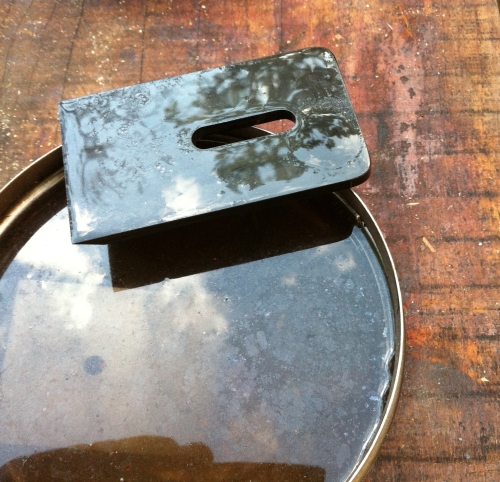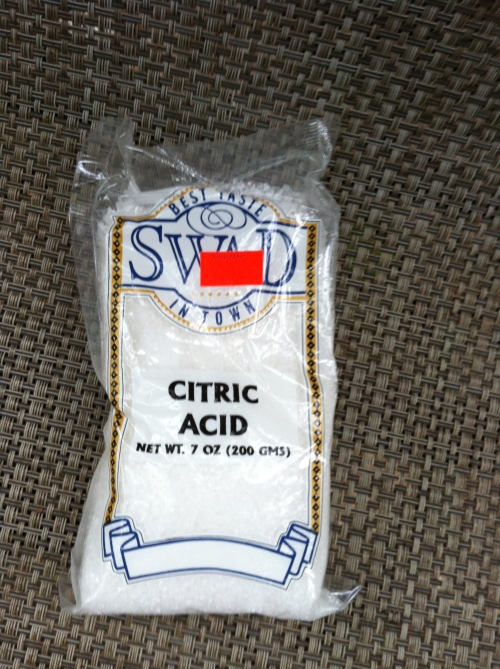There are a lot of simple ways to soak off rust. Here is a comparison of several of these. All the items used in these tests were totally covered in rust before treating.
On the left one part molasses to six parts water for one week. On the right citric acid in water for two days.
This is after one day in distilled white vinegar.
All of these items where too rusty to just rub the rust off with some turpentine or penetrating oil.
Vinegar makes little bubbles while it works.
Metal comes out with a black residue that rubs off easily.
This rubs off and you have a flat grey finish.
So now you have the basic idea. Soaking in some mixtures will remove rust faster than steel is removed. With just a little work, the rust can be rubbed right off.
Make sure that the metal you treat is fully submerged. The borderline between wet and dry can be eaten into and pitted badly by most of these treatments.
So here are a few notes on the different methods. Please be aware that while some of these materials start out being food safe, they can be used to produce materials that are not food safe. Also be aware that some food safe materials can cause issues when skin is exposed to them. I prefer to use food safe materials, but have learned, due to a very serious and painful injury caused by apple juice, that care must still be taken.
I am not kidding about the apple juice. I have scars.
Vinegar is food safe and easy to get. It will help clean and sharpen files. Vinegar will leave a grey finish that is a type of rust crystal that adds a small degree of rust resistance. A lot of old kitchen knives have this finish. I usually leave stuff in vinegar overnight.
Citric Acid is also food safe and used to pickle. I get mine in a 7 oz bag for $3 at an Indian or Pakistani Grocery.
I add enough water to the citric acid to let it fully dissolve. Then I drop rusty metal in it. Rust may take less than a day to be removed.
Molasses is slow, may take a week or so. I mix one part to 6 parts of water. Molasses won’t remove as much steel if you leave it in the bath too long. It seems to be the most gentle on steel.
Phosphoric Acid is one of my favorites, and is considered one of the milder acids available for cleaning cement. Some hardware and some office supplies will stock it. When I use it, it performs a double service. First I use it to remove zinc from steel that I plan to weld or use in my forge. Zinc vapors can cause horrible organ damage so I remove it before I use scrap that is galvanized.
After Phosphoric Acid has removed zinc it becomes a very valuable rust remover. As it removes rust it parkerizes the steel and lends it a touch of rust resistance and a flat grey finish. After using Oxpho Blue on parkerized steel, the result is quite rust resistant and scratch resistant black steel.
The top and third from the top tools in the picture below were treated that way.
Phosphoric acid stops bubbling when the rust is gone and the steel is treated.
As a clarification, All of these recipes use materials that are not going to be bad environmentally, diluted and in the quantities a home user is likely to use. However, in some steels there are elements that can be less healthy when removed from a solid and impermeable matrix. Some toxic metals can become much easier to absorb after acidic interaction. As an example, nickel salts are carcinogenic.
Bob






 A page Dedicated to My Writing
A page Dedicated to My Writing
Thank you for the write-up.
Of these three methods, which one leaves the surface finish of the treated part intact and “as-is” the most?
If the metal is not completely submerged, the borderline at the surface will mangle horribly in every case, so when I treat, the metal is removed from any other materials and fully treated, rusty or not. Since rust can pit, the best way to judge excessive metal removal is to examine the unrusted areas after treatment. All of these acids are slower to eat bare metal than they are rust.
I have not used molasses much, but it does seem to leave the unrusted areas mostly alone. All of these methods leave a dark layer on the surface that needs to be rubbed off. That would be a bit of corrosion in any case. I can’t say for the rest, but zinc coatings are definitely eaten up by phosphoric acid and citric acid.
Bob
What an excellent study in rust removal! I was wondering about the metal after the zinc coating is eaten up, is there any way to age the metal to make it look antique or have a patina for an aging effect.
As far as making a patina, I would advise experimentation. Citric is fairly fast, an you might be able to control patterns with wax or oil.
Bob
[…] Rust Removal « Toolmaking Art. […]
Is there a proper way to dispose of the phosphoric acid when removing the zinc?
Before disposal, you should use the now quite valuable zinc laden phosphoric acid to parkerize with. If you now soak a nice tool in this, it will make it quite a bit more rust resistant. If you then treat it with Oxpho Blue, you can have a really nice dark surface with quite a bit of rust resistance added. As an example,

I modified Bob Smalser’s original method by adding zinc into the phosphoric acid first.
As far as disposal goes, phosphoric acid, zinc and iron are all used to grow things like tomatoes hydroponically. I prefer my food a bit more naturally grown, and the stuff we are using is probably not food grade, but with care and dilution should be healthy enough as a fertilizer for plants unless there is another chemical in your phosphoric acid that you don’t want the residue of in your yard. In the past I have poured it out on an ant bed, but it did not seem effective as an ant killer. The grass around the ant bed did not seem any worse afterwards.
Bob
Hi Bob;
Thanks for the nice article by Bob Smalser! I have a bit of that Jasco in my shop too, along with a little bluing… that marking knife looks somewhat familiar…
Skip
Good to hear from you, Skip! Yes I think it would be familiar!
Bob
Good to be here Bob…. I usually don’t say much, but I lurk around here most days… That magical time of year is coming around again, I plan to finally work on my M&G parts this year.
If I want to put a rusty painted car jack in the molasses mixture will the paint bee moved too?
It might. I have seen paint remove and I have seen paint remain. Only one way to know for sure.
Bob
Hey Bob,
I recently got an old block plane from a friend and I’m the process of cleaning it up. To remove some of the rust, I dunked the depth adjuster in a small container filled with water and powdered citric acid. I walked away and actually forgot about it for a couple of days. I checked on it today and all the nickel plating has come off. Are there any concerns I should have about disposing of or coming into contact with the solution or the part itself?
Very curious about the apple juice incident. Please email details.
In my discussion on Two Layer Milk Paint I also mention the injury.
I wanted to preserve a wooden fence I was making in 2003, so I built a trough big enough to immerse a single wood picket in. The trough was a pair of 2X6 mounted on a 2×12 with end stops. This was on a pair of sawhorses and a bit of plastic sheet was used so that the trough could hold the milk paint mix. The first layer of the two layer milk paint consisted of Powdered milk, frozen apple juice concentrate, water, and copper sulfate. It was quite cold when I was doing this so I was wearing a worn hoodie over a t shirt. While working I was aware that I had soaked the front of my shirt, but pressed on. My wife noticed the wet and cold after I had been working a while and then noticed the chemical burn on my stomach.
The doctor made a point of letting the entire staff see the injury, and remarked to them that a skin graft would not be needed and that I was not in danger. The entire staff individually made a point to hug and reassure my wife that I would live. With each hug and sincere reassurance, my wife became a bit more nervous.
A simple truth about how people work, about the 20th time your wife is assured that you are going to survive, she will begin to think that your time has come.
9 percent of my skin surface however needed regular debridement and treatment. It has take a while, but now the hair has mostly grow back and it mostly looks normal apart from a few scars. For years is was bare and pink.
While copper sulfate is not a great chemical to be exposed to, apple juice is particularly good at breaking down the bonds in skin.
I consider the milk paint recipe well worth using, but I now make sure I have proper protective gear first.
The fence is now 12 years old and it looks comparable to a fence that has been exposed to maybe 6 months of weather.
Here is a an article about my outdoor workshop that shows the fence is 2009, while it is 6 years old.
Here is an article about a tool rack with a French
Cleat that shows the fence in 2012, while it is 9 years old.
Bob
Hello Bob; I’ve been reading this off and on for the past few weeks since you published it. The links are great for re-reading some really great stuff, and I enjoyed that all over again.
However, altho you have mentioned it….this is the first time you have gone into such great detail about the apple juice strength and danger…
What interests me most tho is your comparison of the timeline of exposure of the fence over the years. It seems you have hit on a way to preserve wood at a greater efficiency and lasting ability than the commercial mixes… which are all very expensive and toxic in different ways. Since arsenic was banned years ago, this has been a considerable problem..
Question: Will this mix also keep western red cedar (from the borg)from degenerating at such a rapid pace in our weather patterns????
Thanks!
Keep up the good work;
Skip
It would and does, I also dipped some western red cedar when I did this project. One very important detail however. It is not pretty on red cedar. It it pretty much ruined the natural beauty of the cedar and then added a touch of clammy dull to the effect. It could be the green tint added to red but I also think it bleached the color too. The recipe would need to be adjusted. I have used a single layer lime and borax based milk paint with safflower oil on cedar with great results, but it has been kept indoors.
Ebonizing wood by first putting fine steel wool in vinegar for a few days and then wetting wood with the vinegar can cause some woods to have their appearance age and some woods darken to black. A nice effect on ash and oak with multiple coats. The grain is still evident and the black wood is delightful. When I did this to cedar, it looked bad, dull, dusty, clammy, bleached and splotchy. So my guess is that an acidic layer on cedar is not ideal for appearance. Go figure, since cedar is so acidic.
Bob
Ah yes, thanks! I’ve been wondering about that. Both eastern and western red cedar planed up in my garage still looks as good as it did (planed) years ago. Some of it residing by my finish table got a bit of poly on it from my stairs project and looks great! But I bought both species for outdoor projects, and the normal outdoor finishes just don’t last very long… and the color goes to grey pretty quick.
Sooo, the color would still go bad…. but the wood would be protected… Where do you get the copper sulfate???
Thanks!
Skip
In the Southern United States, Copper Sulphate is available at a lot of agricultural supplies.
For those who don’t have your background, Skip, I am going to add a bit of data on copper sulphate.
It is often used as an herbicide to eliminate algae or aquatic weeds in ponds. It can be effective, but in the South, ponds tend to become more fertile with time. When you poison a pond, the available nutrients do not go away and something else will take over shortly. In the North where the temperatures do not get as high, copper sulphate lingers forever in water and is an ecological disaster. It is often used as a fungicide, in the classic bordeaux mix to treat grapes, melons and berries. So can do good work, but it only when used in an ideal manner.
Bob
Thanks Bob; Of course I should have thought of that myself. I switched to cedar – wrc – years ago to get away from the arsenic of the old treated pine, before the new treatments came out. But I am not getting the long lasting project effect with un-treated cedar outdoors, and I knew that you would know if anyone did…
I must admit the idea of me doing my own chemical treatments – you are fearless in that way – has been a deterrent so far. But I am using phosphoric acid in rust treatments all the time, so I guess proper handling takes care of that.
What is important to me is that if you will use it, even though you are sensitive about such matters, then with care I can too……..
Skip
Please take good care though. While copper sulphate is still a powder, wear a dust mask and eye protection at the very least. Copper sulphate is not kind to eyes or lungs. Once it is in a fluid suspension, the dust mask is not such an issue, but the need for eye protection remains. Keeping reactive fluids off of yourself and others remains important during all of these processes.
Bob
Thanks Bob; actually I Google’d it yesterday to look for sources ( and you’re right, everybody and his dog sells it) and I clicked on the national pesticides page to read up on it. That page is very clear about how to (and how not to) handle it. We have eye protection and chemical gloves left over from our previous work with herbicides, so knowing what to do helps a lot. I use breath masks all the time when spray painting (and did when mixing herbicides), so that is not a problem either.
Then I got off into reading about all the things copper does.. and does not do… so I got a primer about a huge number of uses it has besides treating wood.
Since what I want it for is not to use against the ground, it was interesting to contemplate it’s fungicides’ properties for the rot cedar gets above ground out in the weather.. it is also interesting to compare how little degeneration our outdoor projects suffered made from the mill’s eastern red cedar as compared to how fast western red cedar starts to rot… if only erc (aromatic) was as cheap to buy as wrc is in large quantities at the borg..
Have a great weekend!
Skip
Bob Strawn..I happened across this site while searching for methods of patina and rust removal. I must say it is very informative but my jaw dropped upon reading your near fatal killer apple juice ordeal. Not to make fun of it, how would anyone suspect such a thing could happen, the doctor using you as a teaching aid is a bit two sided but ultimately wise I tink, even if mildly insulting. Still, with that info, there should be a warning label on all apple juice, if its that nasty.
I find this info to be wisdom and should be shared. I hope you dont mind but I posted the link and your story on my Facebook page as a “warning” of sorts. If you have issue, I’ll take it down.
Thanks.